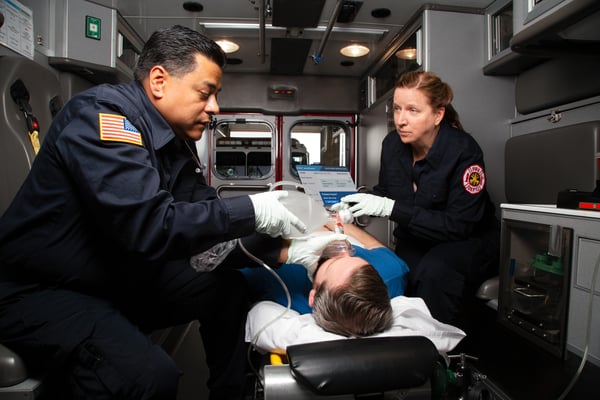News Alert: New ePCR Integration Simplifies EMS Data Management and Enables Better Care Coordination
Looking at STEMI Care Through the Lens of Systems
You took your EMR, EMT or paramedic training – check
Was this information valuable?

You took your EMR, EMT or paramedic training – check. You got all of your continuing medical education covered, including Advanced Cardiovascular Life Support (ACLS) and Basic Cardiac Life Support (BCLS) – check. The rest of the folks on the scene participating in care have all their training and CME – check. You have the latest and greatest equipment on-scene – check. The fire department that provides medical first response services is accredited – check. The ambulance service is accredited – check. The ED docs, cardiologists and nurses finished all their training and continuing medical education (CME) – check. The hospital you are taking your ST-Elevation Myocardial (STEMI) patient to is an accredited hospital and has the latest and greatest equipment – check.
Is that STEMI patient assured that they will get the best possible care? Perhaps, but there is an important element in many communities that stills needs a lot more work. Does the community you serve have a well-functioning system of care for STEMI? Without it, care may not be nearly as effective as it could be.
Bring These Elements into Your System for Excellent Results
Effective STEMI systems of care are the result of efforts to smoothly link the many separate components and steps along the continuum of care – from public recognition of the signs and symptoms and calling 9-1-1; through 9-1-1, medical first response, and ambulance care; into the ED and/or cardiac cath lab and subsequent in-hospital care; and then into cardiac rehabilitation followed by long-term secondary prevention. The most effective systems care also have strong efforts in primordial and primary prevention to keep the STEMI from even happening in the first place. If it’s not already obvious, effective systems of care are also needed for other high-risk, time-sensitive conditions, such as stroke, out of-hospital sudden cardiac arrest, trauma and more.
How do communities establish effective systems of care? There are some common denominators in places that have been getting excellent results. Consider how to bring these elements into your system:
Champions. The champion(s) are the people who get the system integration efforts started. The champions are the ones that push for getting the stakeholders into the same room at the same time. The champions are the ones who catalyze the conversations about stakeholders working together to build an effective system of care. Sometimes, the initial champion is a front line EMS person who has heard of other communities that get great results and wants to bring their community up to similar or higher levels of performance. That initial front line champion may be the one who recruits higher level champions, such as the EMS medical director or administrator, to use their influence to bring other organizations to the table. For STEMI, the champion is often the interventional cardiologist or STEMI care coordinator or an ED doc that is passionate about improving STEMI care.
Stakeholder Meetings. Once the stakeholders are in the room, the higher level champion will often be the person to suggest some ground rules. Acknowledge that there will be difficult issues to address where everyone’s financial and/or political interests aren’t perfectly aligned. The most useful compass through these stormy waters is to have everyone agree that the deciding factor should always be what is in the best interests of patients first, the system second, and individual organizations and providers last.
Objective Data Collection. Without objective data to inform where the baseline level of performance is and how performance changes in response to system changes, the group is flying blind. Effective systems have or acquire the infrastructure to get this done.
Timely Feedback. Even with objective data, if the time from care delivery to feedback is prolonged, too many other things may have happened in the system that influenced results other than the specific change the group made to the system. Effective systems find ways to reduce this lag time to absolute minimums.
Transparency and Accountability. As system changes are agreed upon, it’s important that everyone be willing to contribute their data to the process. Stakeholders in effective systems agree to hold each accountable for bringing data that is timely, valid and ready to merge with the data from others. Effective systems often have external accountabilities to local city councils, public reporting processes, contract requirements, etc. to help compel everyone’s earnest participation.
Resources. Someone needs to be responsible for aggregating the data to create the system level feedback information. Ideally, it’s a trusted third party other than a provider so that real or perceived bias issues are minimized. Effective systems leverage their collective personnel, IT and financial resources to get the jobs done. For that to happen, effective systems have to build trust between stakeholders. The trust creates opportunities for deeper collaboration and more effective changes.
Implementing an Effective System of Care
There are many different strategies to get all of the items mentioned above accomplished. One of the most common are using local medical control/regulatory agencies or committees to champion the cause of better STEMI care and facilitate the stakeholder meetings. Most communities have systems of care for trauma that are based on many of these same principles. Expanding the regional trauma meetings to address STEMI can be an efficient path forward. The American Heart Association has nearly a hundred Quality and System Improvement personnel all across the United States. They can help identify champions, convene stakeholders, and bring resources for data collection and feedback through their Mission: Lifeline program.
Once a community has an effective system of care for STEMI and/or trauma, expanding its scope to include stroke and resuscitation systems of care development is a logical progression.
Related Posts
How STAT MedEvac Connected Device, Software, and Data Technology To Enhance QA and Elevate Care
Podcast: 4 Ways ePCR Software Can Relieve EMS’ Biggest Headaches
ZOLL Pulse Blog
Subscribe to our blog and receive quality content that makes your job as an EMS & fire, hospital, or AR professional easier.
ZOLL Pulse Blog
Subscribe to our blog and receive quality content that makes your job as an EMS, fire, hospital, or AR professional easier.




